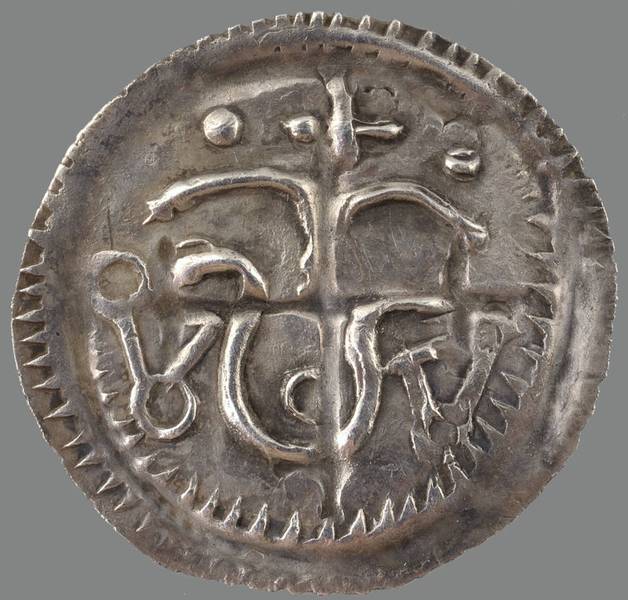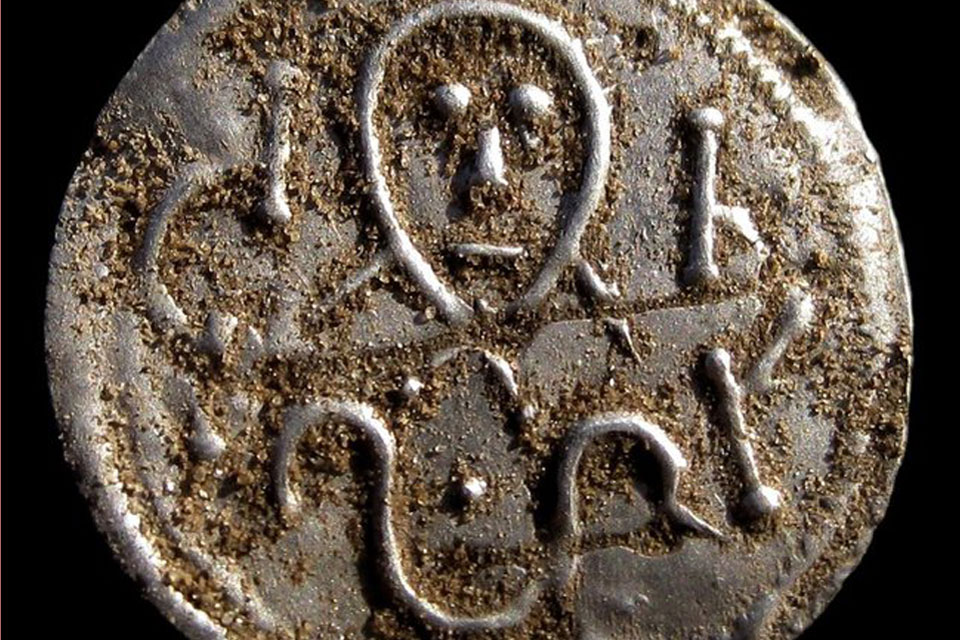Cross coins dominated the local coinage in Denmark during the late reign of Harold Bluetooth from c. 975 – 90 . Recently, a detailed analysis and catalogue was published.
King Harold’s Cross Coinage. Christian Coins for the Merchants of Haithabu and the King’s Soldiers.
By Jens Christian Moesgaard
Publications from the National Museum
Studies in Archaeology and History Vol 20:2. Jelling Series.
Syddansk Universitetsforlag 2015
ABSTRACT

This book presents a detailed analysis of the coin hoards buried in Denmark and Scania during King Harold’s reign, followed by a discussion of the coinage and its function in contemporary Denmark. The recent metal detector and excavation finds suggest that the cross coins were struck in Haithabu, which must have been under firm Danish control throughout the period of production. In this thriving trading place, the coins were used by number in a managed currency, in contrast to the dominant weight economy (coins and other silver artefacts used at weight) in the rest of Denmark. Moreover, King Harold very likely used the coinage for payments to the magnates of his kingdom. The distribution of the coinage was also facilitated by the dearth of silver that followed the decline in the import of Islamic dirhams from Central Asia via Russia in the 960s. The result was a widespread circulation of the Cross coins, which in turn meant the propagation of Christian images via a small and easily exchanged medium.
REVIEW
During the 10th century, Denmark was still a silver economy in the sense that treasures and hoards would consist of both hack-silver and coins. As such, silver was used as what has been called “virtual social glue” by Søren Sivebæk. Silver was a formidable medium to hoard, trade, gift, collect, divide, and inherit. As such, its shifting uses were to be raided (divided), exhibited (as jewellery), exchanged (hacked or gifted), or hoarded (buried). It has been argued that the primary function was to provide visible wealth, which might be gifted to create or uphold social ties through the gatherings of retinues and families (bridal wealth). It has even been argued that the collection of this wealth was a prerequisite for setting up families and that this accordingly was the main reason for why the Viking Age happened.
At some point, however, monetisation took place and silver as an object of social investment was transformed into silver as in coins. Of course, this was never a full and clean transformation. Even in the 18th century rural societies, certain silver coins were regarded as primary “social” objects, which could be gifted at baptises or weddings – and re-circulated inside closed social networks. As is the case, even today, with silver cutlery, and silver pots and pans for weddings.
Nevertheless, when silver pennies were minted and used for transaction in broader context than the closed urban networks of Dorestad, Ribe, Birka, Kupang, and Haithabu, the process of monetisation seems to have been initiated.
The Cross Coins of Harold Bluetooth
In this context, one particular type of coins seems to have played a particular role: the cross coins minted by Harold Bluetooth (c. AD 925 – 986). Until c. 975-80, Islamic dirhams dominated the Viking economy in Denmark. Later, English and German pennies were by far the most common type of coins. However, in between and for a relatively short period a special Danish type of native coins were minted at Haithabu. These coins were called cross coins after the dominant cross on the reverse. The obverse was either designed with curved linages and a face or another cross.
Design
The cross coins are small, fragile and of low weight (c. 0.20–0.35 gr.). They are often called half bracteates as they are so thin, the stamps on the two sides get mixed up. The cross coins are very dissimilar to the contemporary Islamic, Byzantine, German, or English coins of the same period. The nearest model is the Carolus-Dorestad imitations from c. 900 –c. 980. The coins are anepigraphic, thus lacks a legend or an inscription. An attribution of the coins to the reign of Harold Bluetooth is thus circumstantial and consists of a combination of geographic and chronological information as well as the prominent cross-design. The latter refers to the known conversion and baptism of Harold Bluetooth in AD 963(5?), which presents the terminus post quem. The death of Harold around AD 985/6 represents the terminus ante quem. Since two hoards from one of his ring fortresses (Nonnebakken) did not contain these coins, the terminus post quem has been argued to fall between c. 975 – 980. The evidence indicates that the minting period was short but intensive. The geography suggests the coins were minted at the instigation of the king.
Hoards

Studies of hoards from this period have shown that the cross coins must have played a unique role. During the 10th century hoards in Scandinavia and the Baltic were nearly universally composed of two valuables: hack silver and coins. Of these coins, most would show hacking, demonstrating that their silver content had been evaluated and the coins used as payment after weight. The cross coins found in these hoards are, however, unique as they do not show sign of testing. The lack of marks and snips indicates, writes Jens Christian Moesgaard, that these coins were accepted less for their silver-content and more for their symbolic value – as are coins in a managed economy.
Summing up, Moesgaard explains that Harold Bluetooth probably had the coins minted at the emporium at Haithabu, where they were likely used as a managed coinage after c. AD 975, when the Islamic dirhams became scarce. It is also likely that Harold used his coins as symbolically charged payments to the aristocracy and his retinue signalling his Christian conversion and baptism in AD 963. Harold would have been amply aware of the institution of monetisation and managed coinages south and west of his realm. To some extent, Harold succeeded in establishing the new cross coins as accepted managed coins in a Danish context. Finds on the frontier between Denmark and Sweden, in Sweden, Poland, Germany and wider Baltic indicates that elsewhere the cross coins were evaluated as to their pure content of silver. Moesgaard argues that the cross coins are essential witnesses to the bragging of the King on the Great Jelling Stone: that he was “that Haraldr who won for himself all of Denmark and Norway and made the Danes Christian.”
As the coins were used for payment to his retinue, they soon circulated in a wider context, demonstrating that the coins of Harold were not just deemed valuable as symbolic gestures in a gift economy; they soon circulated as part of a more managed coinage.
This book is well-written and well-argued. Moesgaard tells us not just about the coins, but about the transformational period of Harold’s reign, which helped to catapult Denmark onto the centre stage of Medieval Europe. Although both his son, Sweyn Forkbeard, and his grandson, Cnut the Great, came to approach the question of monetisation on a grander scale, the cross coins offer a critical glimpse of the organisational transformation of a pagan warlord into a Christian King, which preceded their reign.
This book amply demonstrates what a detailed micro-study of hoards and coins may contribute to our understanding of historical events like the Christianisation and state-formation of Denmark in the 10th century. Jens Christian Moesgaard is to be congratulated.
READ MORE:
Karen Schousboe
READ ALSO:
Silver Economy in the Viking Age
Ed. by James Graham-Campbell and Gareth Williams
Routledge 2007 (reprint 2016)
Silver Economies, Monetisation and Society in Scandinavia, AD 800 – 1100.
by James Graham-Campbell and Søren M Sindbæk (Editors)
Århus University Press, 2011


